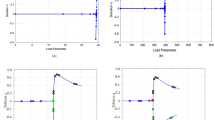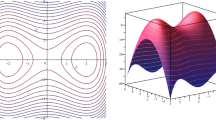Abstract
The majority of the most common physical phenomena can be described using partial differential equations (PDEs). However, they are very often characterized by strong nonlinearities. Such features lead to the coexistence of multiple solutions studied by the bifurcation theory. Unfortunately, in practical scenarios, one has to exploit numerical methods to compute the solutions of systems of PDEs, even if the classical techniques are usually able to compute only a single solution for any value of a parameter when more branches exist. In this work, we implemented an elaborated deflated continuation method that relies on the spectral element method (SEM) and on the reduced basis (RB) one to efficiently compute bifurcation diagrams with more parameters and more bifurcation points. The deflated continuation method can be obtained combining the classical continuation method and the deflation one: the former is used to entirely track each known branch of the diagram, while the latter is exploited to discover the new ones. Finally, when more than one parameter is considered, the efficiency of the computation is ensured by the fact that the diagrams can be computed during the online phase while, during the offline one, one only has to compute one-dimensional diagrams. In this work, after a more detailed description of the method, we will show the results that can be obtained using it to compute a bifurcation diagram associated with a problem governed by the Navier-Stokes equations.
Article PDF
Similar content being viewed by others
Avoid common mistakes on your manuscript.
References
Allgower, E., Georg, K.: Introduction to Numerical Continuation Methods. Society for Industrial and Applied Mathematics, Philadelphia (2003). https://doi.org/10.1137/1.9780898719154. http://epubs.siam.org/doi/abs/10.1137/1.9780898719154
Babuška, I.: Error-bounds for finite element method. Numer. Math. 16(4), 322–333 (1971)
Ballarin, F., Manzoni, A., Quarteroni, A., Rozza, G.: Supremizer stabilization of POD–Galerkin approximation of parametrized steady incompressible Navier–Stokes equations. Technical Report 5, International Journal for Numerical Methods in Engineering (2015)
Barrault, M., Maday, Y., Nguyen, N.C., Patera, A.T.: An empirical interpolation method: application to efficient reduced-basis discretization of partial differential equations. Comptes Rendus Math. 339(9), 667–672 (2004)
Boullé, N., Farrel, P.: Bifurcation analysis with symmetry groups. ENS Rennes and University of Oxford. Summer internship - Report (2017)
Brezzi, F., Rappaz, J., Raviart, P.A.: Finite dimensional approximation of nonlinear problems. I Branches of nonsingular solutions. Numer. Math. 36(1), 1–25 (1980)
Brezzi, F., Rappaz, J., Raviart, P.A.: Finite dimensional approximation of nonlinear problems. II Limit points. Numer. Math. 37(1), 1–28 (1981)
Brezzi, F., Rappaz, J., Raviart, P.A.: Finite dimensional approximation of nonlinear problems. III Simple bifurcation points. Numer. Math. 38(1), 1–30 (1982)
Bürg, M., Dörfler, W.: Convergence of an adaptive hp finite element strategy in higher space-dimensions. Appl. Numer. Math. 61(11), 1132–1146 (2011)
Burger, M.: Numerical methods for incompressible flow. Lecture notes based on lecture notes by René Pinnau, TU Darmstadt (2004)
Canuto, C., Verani, M.: On the numerical analysis of adaptive spectral/hp methods for elliptic problems. Analysis and numerics of partial differential equations, pp. 165–192 (2013)
Canuto, C., Hussaini, M.Y., Quarteroni, A., Zang, T.A.: Spectral Methods: Fundamentals in Single Domains. Scientific Computation, vol. XXII, 581. Springer, Berlin (2006)
Canuto, C., Hussaini, M.Y., Quarteroni, A., Zang, T.A.: Spectral Methods: Evolution to Complex Geometries and Applications to Fluid Dynamics, vol. XXX, 596. Springer Science & Business Media, Berlin (2007)
Constantin, P., Foias, C.: Navier-Stokes Equations. University of Chicago Press, Chicago (1988)
Dijkstra, H.A., Wubs, F.W., Cliffe, A.K., Doedel, E., Dragomirescu, I.F., Eckhardt, B., Gelfgat, A.Y., Hazel, A.L., Lucarini, V., Salinger, A.G., Phipps, E.T., Sanchez-Umbria, J., Schuttelaars, H., Tuckerman, L.S., Thiele, U.: Numerical bifurcation methods and their application to fluid dynamics: Analysis beyond simulation. Commun. Comput. Phys. 15(1), 1–45 (2014)
Fareed, H., Singler, J.R., Zhang, Y., Shen, J.: Incremental proper orthogonal decomposition for pde simulation data. Comput. Math. Appl. 75(6), 1942–1960 (2018)
Farrel, P.E., Birkisson, A., Funke, S.W.: Deflation techniques for finding distinct solutions of nonlinear partial differential equations. SIAM J. Sci. Comput. 37(4), A2026–A2045 (2015)
Farrel, P.E., Beentjes, C.H.L., Birkisson, A.: The computation of disconnected bifurcation diagrams. arXiv:1603.00809 (2016)
Golub, G.H., Van Loan, C.F.: Matrix Computations. Johns Hopkins University Press, Baltimore (2012)
Haasdonk, B.: Convergence rates of the POD-greedy method. ESAIM: Math. Model. Numer. Anal. 47(3), 859–873 (2013)
Hess, M.W., Rozza, G.: A spectral element reduced basis method in parametric CFD. In: European Conference on Numerical Mathematics and Advanced Applications—ENUMATH 2017, vol. 17, pp. 693–701 (2017)
Hess, M., Alla, A., Quaini, A., Rozza, G., Gunzburger, M.: A localized reduced-order modeling approach for pdes with bifurcating solutions. Comput. Methods Appl. Mech. Eng. 351, 379–403 (2019a). ISSN 0045-7825. https://doi.org/10.1016/j.cma.2019.03.050. http://www.sciencedirect.com/science/article/pii/S0045782519301896
Hess, M.W., Quaini, A., Rozza, G.: A spectral element reduced basis method for Navier-Stokes equations with geometric variations. arXiv:1812.11051v2 (2019b)
Hess, M.W., Quaini, A., Rozza, G.: Reduced basis model order reduction for Navier-Stokes equations in domains with walls of varying curvature. Int. J. Comput. Fluid Dyn. https://doi.org/10.1080/10618562.2019.1645328 (2019c)
Hesthaven, J., Rozza, G., Stamm, B.: Certified Reduced Basis Methods for Parametrized Partial Differential Equations. Springer Briefs in Mathematics, Berlin (2015)
Holmes, M., Gray, A., Isbell, C.: Fast SVD for large-scale matrices. In: Workshop on Efficient Machine Learning at NIPS, vol. 58, pp. 249–252, Atlanta (2007)
Huynh, D.B.P., Knezevic, D.J., Patera, A.T.: A static condensation reduced basis element method: complex problems. Comput. Methods Appl. Mech. Eng. 259, 197–216 (2013)
Karniadakis, G.E., Sherwin, S.J.: Spectral/hp Element Methods for CFD. Numerical Mathematics and Scientific Computation. Oxford University Press, New York (2013)
Keller, H.B.: Lectures on numerical methods in bifurcation problems. Springer-Verlag (1987)
Kielhöfer, H.: Bifurcation Theory: an Introduction with Applications to PDEs, vol. 156. Springer Science and Business Media, Augsburg (2006)
Kunisch, K., Volkwein, S.: Galerkin proper orthogonal decomposition methods for a general equation in fluid dynamics. SIAM J. Numer. Anal. 40(2), 492–515 (2002)
Kuznetsov, Y.A.: Elements of Applied Bifurcation Theory. Springer Science and Business Media, Utrecht (2013)
Lassila, T., Manzoni, A., Quarteroni, A., Rozza, G.: Model order reduction in fluid dynamics: challenges and perspectives. In: Quarteroni, A., Rozza, G. (eds.) Reduced Order Methods for Modeling and Computational Reduction, volume 9 of Modeling, Simulation and Applications, chapter 9, vol. 9, pp 235–273. Springer, Milano (2014)
Løvgren, A.E., Maday, Y., Rønquist, E.M.: A reduced basis element method for the steady stokes problem. ESAIM: Math. Model. Numer. Anal. 40 (3), 529–552 (2006)
Maday, Y., Patera, A.T.: Spectral element methods for the navier-stokes equations. In: State-of-the-art Surveys on Computational Mechanics (A90-47176 21-64), pp 71–143, New York (1989)
Maday, Y, Patera, A.T., Rønquist, E.M.: A well-posed optimal spectral element approximation for the stokes problem. Final Report National Aeronautics and Space Administration. Langley Research Center, Hampton (1987)
Mousavi, S., Xiao, H., Sukumar, N.: Generalized gaussian quadrature rules on arbitrary polygons. Int. J. Numer. Methods Eng. 82, 99–113 (2010)
Nektar++: Online documentation. http://doc.nektar.info/doxygen/3.3/class_nektar_1_1_coupled_linear_n_s.html. (Accessed 09 Jan 2019)
Patera, A., Rozza, G.: Reduced basis approximation and a posteriori error estimation for Parametrized Partial Differential Equation. MIT Pappalardo Monographs in Mechanical Engineering. http://augustine.mit.edu, Copyright MIT (2007–2010) (2007)
Pichi, F., Rozza, G.: Reduced basis approaches for parametrized bifurcation problems held by non-linear Von Kármán equations. J. Sci. Comput. 81(1), 112–135 (2019). https://doi.org/10.1007/s10915-019-01003-3
Pichi, F., Quaini, A., Rozza, G.: A reduced order technique to study bifurcating phenomena: application to the Gross-Pitaevskii equation. arXiv:1907.07082 (2019)
Pitton, G., Rozza, G.: On the application of reduced basis methods to bifurcation problems in incompressible fluid dynamics. J. Sci. Comput. 73(1), 157–177 (2017)
Pitton, G., Quaini, A., Rozza, G.: Computational reduction strategies for the detection of steady bifurcations in incompressible fluid-dynamics: applications to coanda effect in cardiology. J. Comput. Phys. 344, 534–557 (2017)
Segal, I.A.: Finite Element Methods for the Incompressible Navier-Stokes Equations. Delft University of Technology (2012)
Seydel, R.: Practical Bifurcation and Stability Analysis. Springer Science and Business Media, New York (2009)
Sherwin, S.J., et al.: Nektar++: an open-source spectral/hp element framework. Comput. Phys. Commun. 192, 205–219 (2015)
Shewchuk, J.R.: Delaunay refinement algorithms for triangular mesh generation. Comput. Geom. 22(1-3), 1–74 (2012)
Sobey, I.J., Drazin, P.G.: Bifurcations of two-dimensional channel flows. J. Fluid Mech. 171, 263–287 (1986)
Solin, P., Segeth, K., Dolezel, I.: Higher-Order Finite Element Methods. Chapman and Hall/CRC, Boca Raton (2003)
Stiefs, D., Gross, T., Steuer, R., Feudel, U.: Computation and visualization of bifurcation surfaces. Int. J. Bifurc. Chaos 18(8), 2191–2206 (2008)
Tritton, D.J.: Physical Fluid Dynamics. Springer Science and Business Media, Oxford (2012)
Ullmann, S., Rotkvic, M., Lang, J.: POD-Galerkin reduced-order modeling with adaptive finite element snapshots. J. Comput. Phys. 325, 244–258 (2016)
Acknowledgments
We acknowledge the support by European Union Funding for Research and Innovation - Horizon 2020 Program - in the framework of European Research Council Executive Agency: Consolidator Grant H2020 ERC CoG 2015 AROMA-CFD project 681447 “Advanced Reduced Order Methods with Applications in Computational Fluid Dynamics” (P.I. Prof. Gianluigi Rozza).
We also acknowledge the INDAM-GNCS project “Advanced intrusive and non-intrusive model order reduction techniques and applications”, 2019.
Funding
Open access funding provided by Scuola Internazionale Superiore di Studi Avanzati - SISSA within the CRUI-CARE Agreement. This work is supported by European Union Funding for Research and Innovation - Horizon 2020 Program - European Research Council Executive Agency: Consolidator Grant H2020 ERC CoG 2015 AROMA-CFD project 681447 “Advanced Reduced Order Methods with Applications in Computational Fluid Dynamics” (P.I. Prof. Gianluigi Rozza) and the INDAM-GNCS project “Advanced intrusive and non-intrusive model order reduction techniques and applications,” 2019.
Author information
Authors and Affiliations
Corresponding author
Additional information
Communicated by: Stefan Volkwein
Publisher’s note
Springer Nature remains neutral with regard to jurisdictional claims in published maps and institutional affiliations.
Authors’ contributions
M. Pintore: running tests and drafting manuscript; F. Pichi: drafting manuscript and test assessment; M. Hess: general code and drafting manuscript; G. Rozza: supervision and preparation of activities; C. Canuto: supervision and manuscript polishing.
Data availability
The program used to obtain all the numerical results is ITHACA-SEM (https://mathlab.sissa.it/ithaca-sem).
Code availability
The code is available at https://github.com/mathLab/ITHACA-SEM.
Rights and permissions
Open Access This article is licensed under a Creative Commons Attribution 4.0 International License, which permits use, sharing, adaptation, distribution and reproduction in any medium or format, as long as you give appropriate credit to the original author(s) and the source, provide a link to the Creative Commons licence, and indicate if changes were made. The images or other third party material in this article are included in the article's Creative Commons licence, unless indicated otherwise in a credit line to the material. If material is not included in the article's Creative Commons licence and your intended use is not permitted by statutory regulation or exceeds the permitted use, you will need to obtain permission directly from the copyright holder. To view a copy of this licence, visit http://creativecommons.org/licenses/by/4.0/.
About this article
Cite this article
Pintore, M., Pichi, F., Hess, M. et al. Efficient computation of bifurcation diagrams with a deflated approach to reduced basis spectral element method. Adv Comput Math 47, 1 (2021). https://doi.org/10.1007/s10444-020-09827-6
Received:
Accepted:
Published:
DOI: https://doi.org/10.1007/s10444-020-09827-6
Keywords
- Spectral element method
- Reduced basis method
- Reduced order model
- Deflated continuation method
- Bifurcation diagram
- Steady bifurcations




